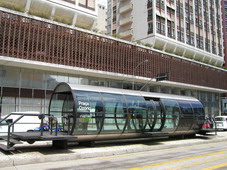Curitiba
|
|
Curitiba_seen_from_above.jpg
Curitiba seen from above
Curitiba is a city in Brazil, the capital of the state of Paraná. In 2001 it had a population of some 1,600,000 people.
The city is on a plateau 3,120 feet above sea level. It is 65 miles west of the sea port of Paranaguá, at 25.42° South, 49.29° West.
| Contents |
History
The name "Curitiba" comes from the Tupi words Coré Etuba, "much pine", due to the high concentration of pine trees previously in the region. The Portuguese who founded a village in 1693 gave it the name of "Vila da Nossa Senhora da Luz dos Pinhais" (Our Lady of the Light of the Pines). The name was changed to "Curitiba" in 1721.
Curitiba officially became a city in 1842. Growth was based on trade, leasing of winter homes, and offices for cattle traders. Curitiba became the capital of the state of Paraná in 1854. Schools and theaters were built.
In 1870, the first European immigrants, mostly Germans, Poles, Ukrainians and Italians, arrived in Curitiba. A smaller number of Japanese, French, and Swiss immigrants established colonies near the city, mainly devoted to agriculture and traditional craftwork. During the 1900's, also Arabs (mainly Syrian and Lebanese), Dutch, Russians, Chinese and Jewish immigrants established a presence in Curitiba.
In 1913, the Universidade Federal do Paraná (Federal University of Paraná State), the first of its kind in Brazil, was built, along with the electrification of streetcars.
Curitiba is part of the Sister City project, and its sister cities include Himeji, from Japan, and Orlando, FL, USA. It was also chosen to serve as the 2003 American Capital of Culture (jointly, with Panama City).
Planning
Curitiba is held as a paragon of urban planning excellence. The city has a notably efficient transportation system, including devotion of lanes on major streets for a bus rapid transit system. The buses are long, split into three sections, and stop at designated elevated tubes, complete with handicapped access. The system, used by 85% of Curitiba's population, is similar to the TransMilenio in Bogotá, Colombia. The city is also remarkably successful in preserving and caring for its green areas, boasting 54 m˛ of green space per inhabitant.
By the 1960s, Curitiba's population had ballooned to 430,000, and some residents feared that the growth in population threatened to drastically change the character of the city. In 1964, Mayor Ivo Arzua solicited proposals for urban design. Architect Jaime Lerner, who later became mayor, led a team from the Universidade Federal do Paraná that suggested strict controls on urban sprawl, a reduction in traffic in the downtown area, preservation of Curitiba's Historic Sector, and a convenient and affordable public transit system. This plan, known as the Curitiba Master Plan, was adopted in 1968. Lerner closed Rua XV de Novembro, one of the main streets, to traffic and adopted a new road design to minimize traffic. This design, called the Trinary Road System, uses two one-way streets moving in opposite directions which surround a smaller, two-lane street.
In the 1980s, the Rede Integrada de Transporte (Integrated Transport Network) was created, allowing transit to any point in the city by paying just one fare. The city also begun an interesting project called the "Faróis de Saber" (Lighthouses of Knowledge). These Lighthouses are free educational centers which include libraries, Internet access, and other cultural resources.
Today, Curitiba is considered one of the best examples of urban planning on the planet. In June 1996, the chairman of the Habitat II summit of mayors and urban planners in Istanbul praised Curitiba as "the most innovative city in the world."
Transportation
Recently, the city installed about 200 traffic radars in the streets, to help decrease the number of accidents. This technology uses sensors below the pavement which trigger a digital camera. The picture, including date and time, is sent to the driver´s home, as a speeding ticket. The system can send these tickets to drivers anywhere in Brazil. The speed limit is about 60 KM/h downtown, but near schools, it can be 20 KM/h.
The city hosts a very well respected 'above ground subway' system, consisting of boarding platforms located above ground, and high speed multi-door buses with frequent service.
Weather and Climate
Being in Southern Brazil, Curitiba is a very humid city in the Temperate Zone. During summer, the average temperature is roughly 21°C, and during winter, 13°C, falling below 0°C in the very coldest days. Humidity, wind and persistent rain contribute to its popular fame as one of the coldest cities in the country.
The climate is unpredictable. Heat waves during the winter and cold waves during the summer are not uncommon, and even during a single day there can be a lot of variation. A local saying is that "Curitiba is a city in which the seasons are clearly defined, and it has all four every day". In April, it rains constantly. You can check Curitiba's weather in Simepar (http://www.simepar.br).
External links
- Curitiba official website (http://www.curitiba.pr.gov.br/pmc/ingles/index.html)
- Official Hotel Guide (http://www.webhotel.com.br)
- Curitiba guide (http://www.curitiba-brazil.com)
- Brazil (http://www.geographicguide.com/brazil.htm)
- article describing transport system in Curitiba (http://www.solutions-site.org/artman/publish/article_62.shtml)da:Curitiba
de:Curitiba es:Curitiba fr:Curitiba it:Curitiba nl:Curitiba no:Curitiba pl:Kurytyba pt:Curitiba sv:Curitiba

